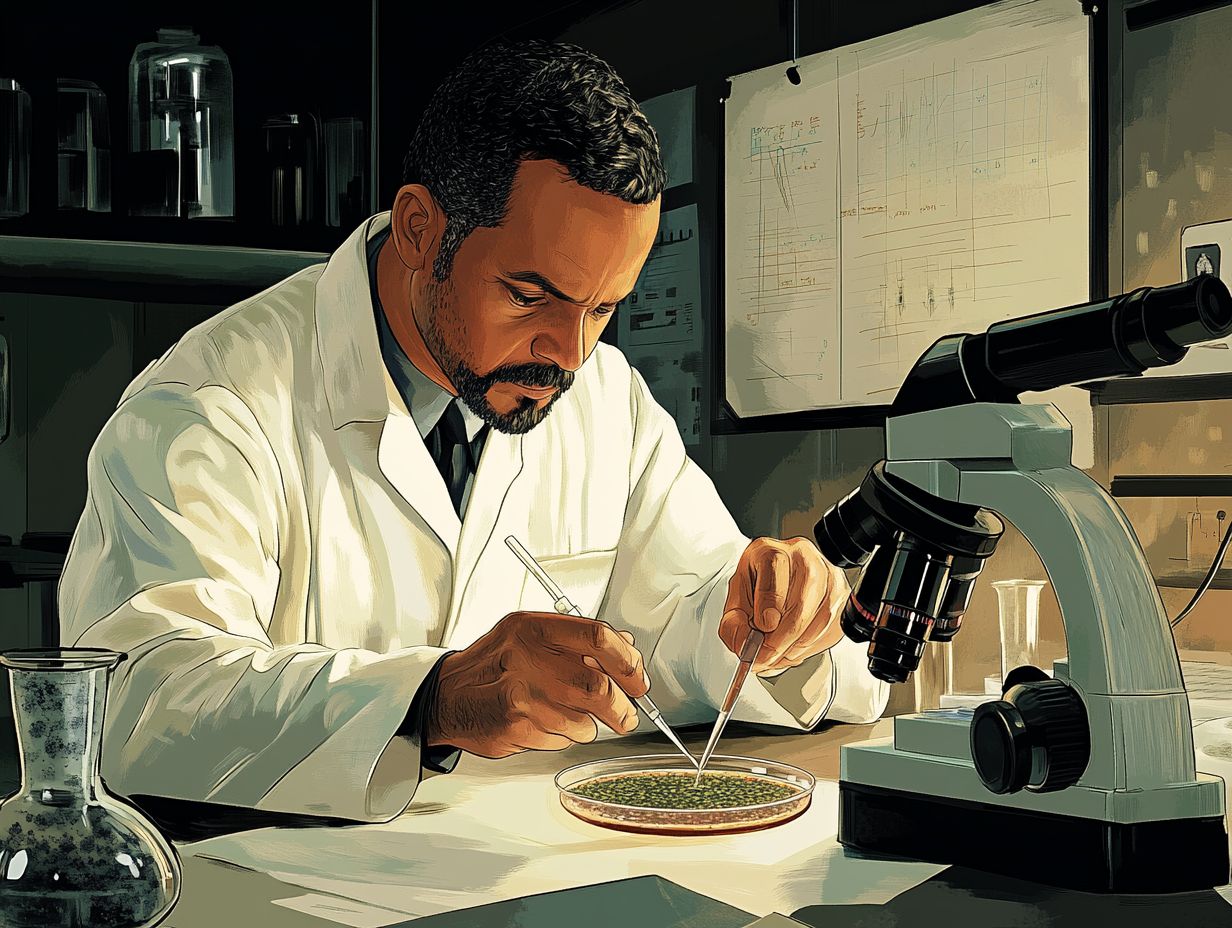Diagnosing Yeast Health Problems
Contents
- Understanding Yeast Infections
- Key Takeaways:
- Types of Yeast Infections
- What Are The Symptoms Of Yeast Infections?
- 1. Itching and Irritation
- 2. Redness and Swelling
- 3. Discharge
- How Are Yeast Infections Diagnosed?
- 3. Lab Tests
- What Are The Treatment Options For Yeast Infections?
- How To Prevent Yeast Infections?
- 5. Maintain A Healthy Diet
- Frequently Asked Questions
- What are some common signs and symptoms of yeast health problems?
- Can yeast health problems be diagnosed through a blood test?
- How does a doctor diagnose yeast health problems?
- Is it possible to self-diagnose yeast health problems?
- Are there any risk factors for developing yeast health problems?
- Can yeast health problems be prevented?
Understanding Yeast Infections
Yeast infections represent a prevalent yet frequently misunderstood health concern that can impact various areas of the body.
Conditions like candidiasis, thrush, and vaginal infections can present a spectrum of symptoms, often resulting in discomfort and irritation. Common yeast infection symptoms include vaginal discharge, burning sensation, and discomfort during sexual activity.
Grasping the nuances of the different types of yeast infections, their diagnostic processes, and the treatment options available is essential for effective management and prevention.
This article delves into the fundamentals of yeast infections, exploring their symptoms, diagnosis, treatment approaches, and strategies for prevention.
Key Takeaways:

- Candidiasis, Intertrigo, Thrush, Vaginal Yeast Infections, and Diaper Rash are the most common types of yeast infections.
- Itching and irritation, redness and swelling, vaginal discharge, painful urination or sex, and rash or sores are common yeast infection symptoms.
- Physical examination, medical history, and lab tests are used to diagnose yeast infections.
Types of Yeast Infections
Yeast infections, especially those that are vaginal in nature, encompass a range of types, each attributed to different strains of Candida a fungus that can result in discomfort and health complications for women.
The most prevalent forms include candidiasis, intertrigo, thrush, and diaper rash, each exhibiting distinct characteristics and symptoms that can significantly impact the vaginal flora and overall well-being.
Understanding these variations is essential for maintaining optimal women’s health and addressing any potential concerns effectively.
1. Candidiasis
Candidiasis, commonly known as a vaginal yeast infection, arises primarily from too much Candida fungus. If you re experiencing symptoms like vulva itching, vaginal discharge, and discomfort, it s essential to understand the causes.
Several factors can contribute to this imbalance. For instance, the use of antibiotics can disrupt the natural vaginal flora, creating an environment for yeast to flourish.
Hormonal shifts caused by menstruation, pregnancy, or hormone replacement therapy can foster an environment that allows yeast to thrive. If you have diabetes, elevated glucose levels in your bodily secretions might further encourage Candida growth.
Regarding treatment options, antifungal medications prescribed by healthcare providers are often the first line of defense. You may also find various over-the-counter treatments that aim to restore the natural balance of your flora. It not only alleviates your symptoms but also helps to prevent future occurrences. It’s crucial to follow treatment compliance as per medical guidelines to avoid recurrent yeast infections.
2. Intertrigo
Intertrigo is a yeast infection that commonly occurs in moist skin folds, where friction and limited airflow give rise to inflammation and irritation, particularly in areas like the groin and underarms.
These conditions create an ideal breeding ground for yeast overgrowth, leading to discomfort and visible symptoms such as redness, burning, and itching. Prioritizing proper hygiene is key to preventing intertrigo. By keeping affected areas dry and well-ventilated, you can significantly decrease the chances of yeast flourishing in these delicate skin folds.
Treatment may include antifungal creams and powders, along with a keen focus on personal care routines to ensure moisture is effectively managed, helping your skin heal and stay healthy.
If you suspect you have a yeast infection, consider consulting a healthcare professional for advice and treatment options.
3. Thrush
Thrush, or oral candidiasis, is a fungal infection that can take up residence in your mouth, presenting itself with white patches on your tongue and inner cheeks. It’s often accompanied by discomfort, including pain or a burning sensation that can be quite bothersome. This condition is often seen in individuals with a compromised immune system.
This condition can arise from a variety of factors, with an imbalanced microbiome playing a crucial role. Typically, your oral ecosystem thrives on a delicate balance between beneficial bacteria and fungi. When this balance is disrupted, it paves the way for an overgrowth of Candida, the culprit behind thrush. Risk factors include the use of oral contraceptives and antibiotics.
If your immune system is compromised, you may find yourself more susceptible to this unwelcome invader, as your body struggles to fend off fungal intrusions. For management and treatment, antifungal medications are often prescribed to help you regain control. Popular antifungal treatments include fluconazole, miconazole, and terconazole.
Additionally, you might consider home remedies, such as saltwater rinses or incorporating probiotic-rich foods into your diet, which can effectively aid in restoring your oral health and alleviating those pesky symptoms. It’s also advisable to maintain a balanced diet to support a healthy microbiome.
4. Vaginal Yeast Infections
Vaginal yeast infections rank among the most common infections women encounter, often stemming from an imbalance in vaginal flora. Factors such as hormonal fluctuations, antibiotic use, and elevated glucose levels can contribute to this imbalance, leading to symptoms like vulvar itching and unusual discharge. These symptoms can cause significant discomfort in the vagina.
Regarding diagnosing this condition accurately, healthcare providers typically conduct a pelvic exam to visually assess the vaginal area and collect samples for yeast testing. These tests may involve a simple culture or a microscopic examination to confirm the presence of the Candida fungus, the notorious culprit behind the infection. A thorough medical history and a detailed pelvic examination are essential for accurate diagnosis.
Once a diagnosis is made, treatment options generally include antifungal medications that can take the form of topical creams, ointments, or oral tablets. It’s essential for you to take charge of your health by practicing good hygiene, opting for breathable underwear, and maintaining a balanced diet to help prevent these infections from making a comeback. Consider discussing with your healthcare provider to tailor the best treatment options for you.
Discussing any symptoms with a healthcare professional is crucial for achieving an accurate diagnosis and effective treatment, ensuring you re well on your way to feeling your best. This can prevent chronic infections and improve women’s health overall.
5. Diaper Rash
Diaper rash is a common concern for infants, and it can sometimes escalate into a more complicated issue, such as a yeast infection, especially when moisture and friction create a perfect storm for Candida overgrowth. Proper hygiene is crucial for preventing such fungal infections.
This discomfort can lead to crying and irritability, making it essential for you as a caregiver to grasp the factors contributing to diaper rash. Poor hygiene, prolonged exposure to wet diapers, and even changes in diet can heighten the risk of this skin condition.
To effectively prevent diaper rash, it s vital to change diapers frequently and ensure that the skin stays dry and clean. Applying barrier creams can also provide a protective shield for delicate skin.
Should a yeast infection occur, you may notice that the symptoms intensify, presenting as red, raised bumps. Treatment typically involves antifungal creams along with maintaining optimal dryness.
Practicing good hygiene is crucial in minimizing the risk of both diaper rash and its complications.
What Are The Symptoms Of Yeast Infections?
The symptoms of yeast infections can differ depending on the type and location of the infection, but you ll likely notice some common signs. These may include:
- itching
- redness
- swelling
- abnormal discharge
- discomfort during urination or sexual activity
Each of these symptoms can profoundly affect your health and overall quality of life. It’s crucial to consult your healthcare provider for an accurate diagnosis and effective treatment.
1. Itching and Irritation

Itching and irritation are hallmark symptoms of yeast infections. These sensations are often felt in the vulva and vagina, leading to discomfort and distress.
Such sensations typically arise from an imbalance in the healthy bacteria found in the vagina. Hormonal fluctuations, antibiotic use, and a diet high in sugars can disrupt this balance, allowing Candida overgrowth. Maintaining healthy bacteria like Lactobacillus helps prevent infections.
This overgrowth causes irritation and can lead to unusual discharge along with a burning sensation during urination or intercourse. Practicing self-care is vital maintaining proper hygiene, opting for breathable fabrics, and avoiding irritants can truly make a difference!
If the itching persists or worsens, consult a healthcare professional. Ongoing issues may signal underlying conditions that require medical attention. Clinics like the Cleveland Clinic and Mayo Clinic provide expert care for chronic infections.
2. Redness and Swelling
Redness and swelling in the vaginal area may indicate a yeast infection, often accompanied by a burning sensation and discomfort.
These signs arise from your body’s reaction to an overgrowth of yeast, primarily Candida. While Candida naturally resides in the body, it can multiply under specific conditions, leading to an imbalance. This imbalance may prompt you to seek medical attention.
Factors like hormonal changes, antibiotic use, and a diet high in sugars can contribute to this imbalance. An effective diagnosis involves a thorough evaluation, including physical examinations and lab tests to confirm the type of infection.
Treatment options vary, ranging from over-the-counter antifungal medications to prescription therapies, depending on the severity. Consistent communication with your healthcare provider is key to successful treatment.
Consulting healthcare professionals is crucial for anyone experiencing symptoms like vulva itching or a burning sensation. This ensures that you receive the proper care and management you need!
3. Discharge
Abnormal vaginal discharge is a common symptom of yeast infections. It is typically characterized by a thick, white consistency resembling cottage cheese often a sign of Candida overgrowth or vaginal candidiasis.
However, other types of discharge can arise from infections in the vaginal area. For instance, bacterial vaginosis often presents as a grayish or milky discharge with a fishy odor, indicating an imbalance in the natural bacteria. Sexually transmitted infections, like trichomoniasis, can lead to a frothy, yellow-green discharge with a strong smell.
It is essential to monitor any changes in your discharge, as these variations can signal an underlying infection, such as a vaginal yeast infection. Keeping track of these yeast infection symptoms aids in early detection and facilitates timely medical intervention, helping you prevent potential complications.
4. Painful Urination or Sex
Experiencing painful urination or discomfort during sexual activity can often accompany a yeast infection, resulting in significant distress and discomfort, particularly due to the inflammation in the vulva and vagina caused by yeast overgrowth.
This inflammation can create a relentless cycle of soreness, where irritation from the infection amplifies the pain during urination and intercourse, turning even everyday activities into sources of distress. As the delicate tissues become swollen and sensitive, you might find that even the slightest friction leads to heightened discomfort, similar to the symptoms experienced in vulvodynia.
Many healthcare providers emphasize the necessity of adhering to treatment protocols to manage these symptoms effectively. They typically recommend antifungal medications and may suggest additional methods to soothe the inflammation. Following their healthcare advice is essential for a smoother and more comfortable recovery.
If you’re struggling with these symptoms, urgent action is key! Contact a healthcare provider today for tailored advice.
5. Rash or Sores
Rashes or sores, including vaginal rash, may arise from yeast infections, signaling a more serious reaction or a secondary infection that calls for prompt medical attention.
These symptoms often appear as red, inflamed patches on the skin or even as blisters or painful lesions, potentially causing significant discomfort and concern. It’s important to recognize that while these symptoms might seem manageable at first, they could point to an underlying issue, such as chronic infections or a worsening of the infection.
Treatment options might include topical antifungal creams, oral medications, or over-the-counter remedies specifically formulated to relieve yeast-related discomfort. Avoid the temptation to self-diagnose or self-treat without consulting a healthcare provider. They can offer a proper diagnosis of a yeast infection and a customized treatment plan to address these troubling symptoms effectively.
How Are Yeast Infections Diagnosed?
When diagnosing a yeast infection, you can expect a comprehensive evaluation by your healthcare provider. This process often includes a pelvic exam, a detailed review of your medical history, and lab tests aimed at confirming the presence of Candida a type of yeast that can cause infections overgrowth in your vagina.
In some cases, a yeast test or vaginal culture might be necessary to identify the specific type of fungi involved.
1. Physical Examination
A physical examination, especially a pelvic exam, is an essential part of diagnosing yeast infections. It allows healthcare providers to directly assess symptoms such as redness, swelling, and discharge, which are common yeast infection symptoms.
During the exam, the provider will carefully examine the vulva and vaginal walls for any signs of irritation or inflammation that may suggest an underlying infection. You can expect the healthcare professional to ask you about your medical history, including any previous yeast infections and related symptoms like itching or burning sensations. They may also inquire about factors like antibiotic use and oral contraceptives that could influence your condition.
The provider may also perform a swab test to collect samples from the vaginal area, which helps identify the presence of Candida or other microbial organisms. This thorough assessment not only aids in confirming a diagnosis but also guides you toward the most appropriate treatment options, such as antifungal treatments, underscoring the importance of this initial diagnostic step.
2. Medical History
A thorough review of your medical history is essential for diagnosing yeast infections. It allows healthcare providers to pinpoint potential risk factors that could be at play, such as antibiotic use, hormonal changes, and underlying conditions like diabetes or a weakened immune system.
Furthermore, your comprehensive medical history can shed light on lifestyle choices, including dietary habits and stress levels, which might also contribute to those pesky recurrent yeast infections. By understanding your previous health issues and how you ve responded to treatments, your healthcare provider gains valuable insights into how your body reacts in various situations. This context helps identify patterns over time, paving the way for personalized treatment options and preventive measures.
Ultimately, integrating detailed medical histories into the diagnostic process enhances the effectiveness of managing recurrent yeast infections, promoting both your physical and emotional well-being, as well as improving healthcare communication.
3. Lab Tests

Lab tests, such as yeast tests and vaginal cultures, are essential for accurately diagnosing yeast infections. These tests help confirm the presence of Candida and rule out other potential infections. They are often recommended by institutions like the Mayo Clinic and Cleveland Clinic.
These diagnostic methods enable healthcare providers to identify the specific type of yeast involved and evaluate the underlying causes of the infection. Common laboratory techniques include culture tests, where a sample is taken from the affected area and grown in a controlled environment to identify the yeast species.
Increasingly, PCR (a lab technique that helps identify the genetic material of the yeast) tests are being utilized for their ability to detect genetic material, resulting in rapid and precise outcomes. Understanding the vaginal flora is crucial in determining the proper treatment.
A successful culture can indicate an active infection, while negative results may point to a different issue, guiding you toward the most appropriate treatment options. This ensures an accurate and comprehensive diagnosis of your yeast infection.
What Are The Treatment Options For Yeast Infections?
Regarding treating yeast infections, you have a range of options at your disposal. These can encompass antifungal medications, effective home remedies, and thoughtful lifestyle changes designed to restore balance to your vaginal microbiome and prevent future infections from occurring.
1. Antifungal Medications
Antifungal medications like fluconazole, miconazole, and terconazole are frequently prescribed for yeast infections. These medications are specifically designed to target and eliminate Candida, providing you with much-needed relief from symptoms.
These medications are available in a variety of forms, including oral tablets, topical creams, and suppositories, giving you the flexibility to choose the treatment that best suits your needs. For instance, you might prefer oral fluconazole for its convenience and the advantage of a single-dose treatment, while topical options can deliver direct action right where it s needed. Such antifungal treatments are highly effective in managing vaginal candidiasis.
Remember that dosages can vary depending on the severity of your condition and your individual health circumstances, so it’s crucial to follow medical guidelines to ensure the best possible outcomes.
It s also important to be aware of potential side effects, such as gastrointestinal disturbances or skin reactions, which could affect your adherence to the treatment plan. Understanding these factors empowers you to manage your condition more effectively and enhance your overall experience during treatment. Ensuring treatment compliance is key to achieving a full recovery.
2. Home Remedies
Home remedies can offer relief and support in the treatment of yeast infections. Options such as probiotics, garlic, and coconut oil are popular choices that many individuals find effective. These remedies help restore microbiome balance and support the growth of healthy bacteria like Lactobacillus.
These remedies often attract attention due to their accessibility and the perception that they are safer alternatives to conventional medicine. Probiotics help restore the natural balance of bacteria in your body, while garlic is known for its antifungal properties, providing a potential shield against yeast growth. Coconut oil, rich in medium-chain fatty acids, may also play a role in combating the infection.
However, it s essential to approach these treatments with caution. You may encounter allergic reactions or other unintended side effects. Therefore, consulting a healthcare provider before starting any home remedy is crucial to ensure a safe and customized treatment plan tailored to your needs, as recommended by institutions such as the Cleveland Clinic.
3. Lifestyle Changes
Good Hygiene
Maintaining good hygiene is vital in preventing yeast infections, as it helps keep a balanced vaginal flora and minimizes the risk of Candida overgrowth, also known as candidiasis.
Incorporating specific hygiene practices, such as wearing breathable cotton underwear, is essential. This allows for proper airflow and prevents moisture buildup, which can create a breeding ground for fungal growth. Regular bathing and ensuring the genital area is thoroughly dried after showering can further discourage yeast proliferation.
It s also wise to avoid douching and heavily scented products, as these can disrupt your natural pH balance.
Clothing Choices
Choosing breathable fabrics, such as cotton, instead of tight, synthetic materials enhances air circulation. This helps to reduce warmth and dampness, which can foster yeast growth.
Dietary Habits
A balanced diet that limits high-sugar foods is crucial, as regulating blood sugar levels helps prevent yeast overgrowth and fungal infections. Adopting a mindful diet rich in probiotics can support your overall health and contribute to maintaining harmony in your vaginal flora.
Together, these lifestyle modifications contribute to a healthier microbiome, ultimately reducing the risk of infections, including vaginal candidiasis, and promoting your well-being.
How To Prevent Yeast Infections?
Preventing yeast infections requires a comprehensive strategy that encompasses several key practices. You should prioritize good hygiene, steer clear of irritants, and limit your use of antibiotics. Understanding the symptoms of yeast infections, such as vaginal discharge, vulva itching, and burning sensations, is crucial for early intervention.
Opt for breathable clothing to enhance comfort, and focus on maintaining a healthy diet that supports your immune system and promotes a balanced microbiome. Including fermented foods rich in Lactobacillus can be beneficial.
1. Practice Good Hygiene
Practicing good hygiene is essential for preventing yeast infections. It helps maintain a balanced vaginal flora and minimizes the risk of Candida overgrowth, also known as candidiasis.
Incorporating specific hygiene practices, such as wearing breathable cotton underwear, is crucial. This allows for proper airflow and prevents moisture buildup. Regular bathing and ensuring that the genital area is thoroughly dried after showering can further discourage yeast proliferation.
It s also wise to avoid douching and heavily scented products that can disrupt your natural pH balance. Understanding that topical medications like miconazole and terconazole can be necessary in case of infection is important.
Over-the-counter treatments and antifungal medications should be considered if symptoms escalate. Act quickly at the first signs of a yeast infection to ensure prompt relief.
Take control of your health today by implementing these strategies!
2. Avoid Irritants
Importance of Gentle Products
Avoiding irritants like scented hygiene products and harsh soaps is essential for preventing yeast infections. These can disrupt the delicate balance of your vaginal microbiome.
Using gentle, unscented products is vital for keeping your vagina healthy. You may be surprised to learn that certain ingredients in flashy hygiene products can cause irritation, creating an environment that invites infections.
Choosing the Right Cleanser
Managing estrogen levels and avoiding triggers that could lead to vaginal rash or discomfort is also crucial. Choosing pH-balanced cleansers and steering clear of douching practices supports your vaginal flora and helps maintain balance.
Listening to Your Body
By educating yourself on ingredient lists and selecting products specifically designed for intimate areas, you can make a significant difference. Healthcare providers emphasize the importance of such practices to maintain vaginal health.
Trust your body; it often knows best. Listening to its needs is key to maintaining your overall health and comfort. Don t wait consult your healthcare provider for crucial insights on managing symptoms of infection.
3. Wear Breathable Clothing

Wearing breathable clothing, especially cotton underwear, is a smart strategy to help prevent yeast infections. It promotes airflow and reduces moisture buildup in the vaginal area, creating a healthier environment.
In addition to cotton, consider opting for loose-fitting garments made from natural fabrics like linen or bamboo. These materials significantly contribute to yeast infection prevention by allowing your skin to breathe, keeping the intimate area dry and comfortable.
Stay away from synthetic fabrics like polyester, which can trap heat and moisture, fostering an environment where yeast can thrive. When hitting the gym, select moisture-wicking activewear, as these fabrics effectively pull sweat away from your skin.
This choice is particularly important during sexual activity, which can increase warmth and moisture in the vaginal area. On warmer days, think about opting for skirts or dresses to enhance ventilation and ensure comfort while enjoying the sun.
4. Limit Antibiotic Use
Limiting your use of antibiotics is crucial for preventing yeast infections, as these medications can disrupt the delicate balance of healthy bacteria in your microbiome, leading to an overgrowth of yeast. This is especially important for women at risk of recurrent yeast infections.
When you receive a prescription for antibiotics, recognize their potential impact on your vaginal health. While they effectively target harmful bacteria, they can also unintentionally disrupt beneficial microorganisms, contributing to discomfort and infections.
Consulting with a healthcare provider before starting or stopping any antibiotic treatment is essential. They can discuss treatment options like fluconazole for mitigating yeast infection symptoms and offer valuable guidance on maintaining your microbiome’s balance.
This ensures any treatment you pursue aligns with your individual health needs while minimizing the risks associated with antibiotic use. They may also recommend over-the-counter antifungal treatments based on your condition.
5. Maintain A Healthy Diet
Maintaining a healthy diet is essential for preventing yeast infections. A nutritious diet bolsters your immune system and helps regulate glucose levels, both of which can influence Candida growth. This is particularly important for individuals with diabetes who are at a higher risk of yeast infections.
A well-rounded nutritional approach emphasizes whole foods that are low in added sugars and refined carbohydrates. These can spike blood glucose levels and create a favorable environment for yeast overgrowth. Incorporating a variety of vegetables, lean proteins, and healthy fats into your daily meals provides your body with vital vitamins and minerals that enhance your immune response. Dietary choices play a crucial role in infection prevention.
Embracing fermented foods, which are rich in probiotics beneficial bacteria that help maintain gut health can greatly lower your risk of infections. Foods high in fiber are also beneficial, as they help maintain balanced digestion and regulate sugar absorption. This can reduce the likelihood of chronic infections.
By consciously selecting these dietary options, you can significantly lower your chances of facing recurrent infections. It’s essential to be mindful of hormonal changes that may also affect your susceptibility to yeast infections.
Frequently Asked Questions
What are some common signs and symptoms of yeast health problems?
Common signs and symptoms include frequent yeast infections, digestive issues, skin rashes, fatigue, and brain fog. Discomfort in the vagina, burning during urination, and abnormal discharge are also notable symptoms.
Can yeast health problems be diagnosed through a blood test?
In some cases, a blood test may be used to diagnose yeast health problems. However, this method is not always the most accurate. Other diagnostic tests, such as a vaginal culture or yeast test, may be necessary.
How does a doctor diagnose yeast health problems?
A doctor may diagnose yeast health problems by taking a thorough medical history, performing a physical exam, and ordering diagnostic tests such as a stool or urine analysis. A pelvic exam may also be conducted to check for signs of infection.
Is it possible to self-diagnose yeast health problems?
It’s best to avoid self-diagnosing yeast health problems since the symptoms can resemble those of other health conditions. Always consult a healthcare professional for an accurate diagnosis. Self-diagnosis could lead to improper treatment and worsen the condition.
Are there any risk factors for developing yeast health problems?
Risk factors include a weakened immune system, frequent use of antibiotics, hormonal changes, and a diet high in sugar and refined carbohydrates. Oral contraceptives and sexual activity can also contribute to these risks.
Can yeast health problems be prevented?
There are steps you can take to help prevent yeast health problems. These include maintaining a healthy diet, managing stress levels, and avoiding triggers like antibiotics and sugar. However, some yeast health problems may not be preventable. It’s advisable to consult healthcare providers for personalized healthcare advice.






